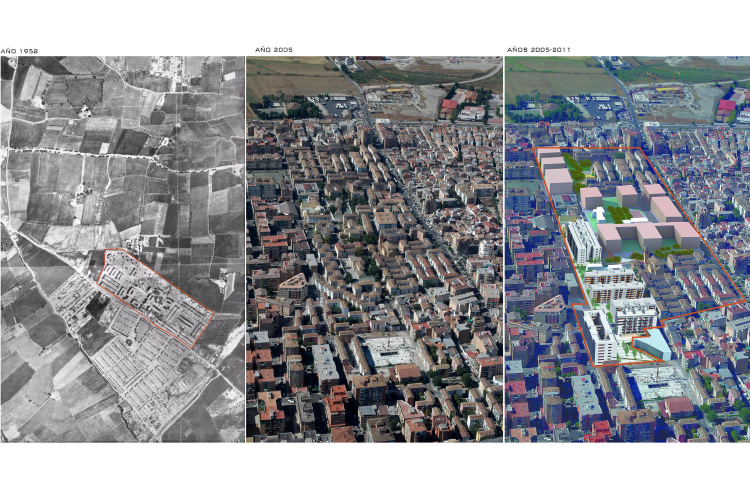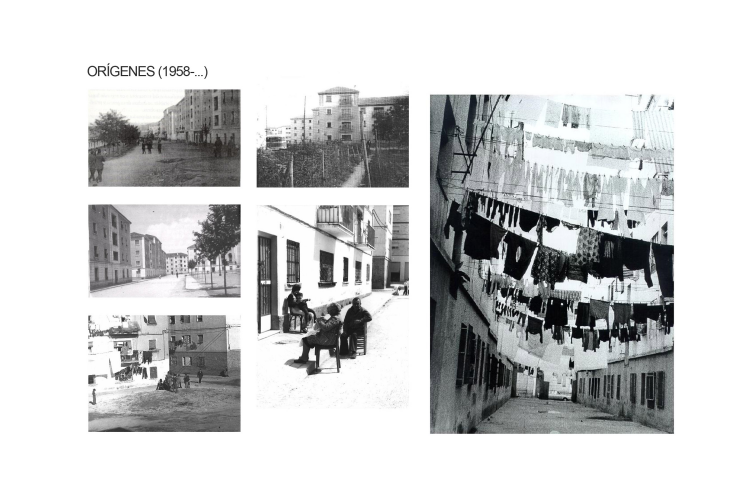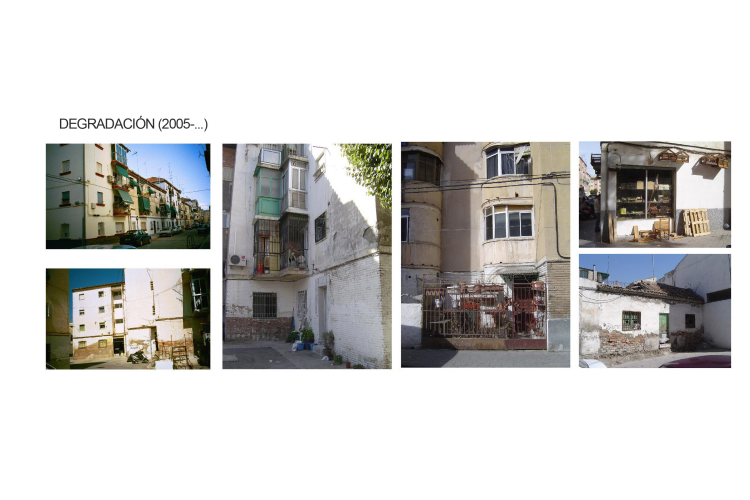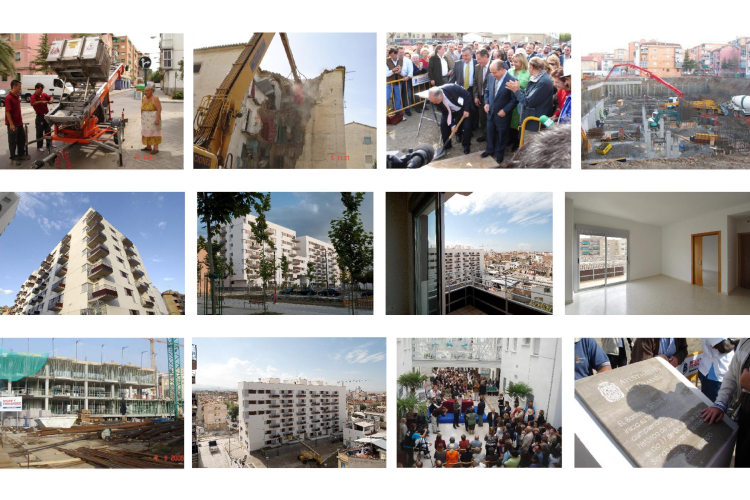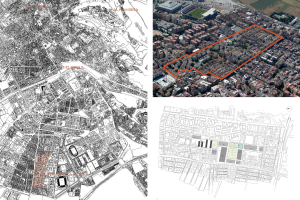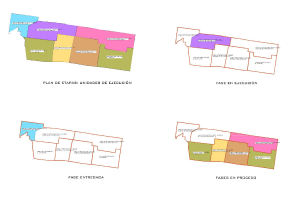The reform plan Santa Adela is comprehensive urban renewal of a neighborhood comprised of nearly 1,500 homes distributed in blocks of public housing built by the Patronato de Santa Adela urgently over 50 years ago to house the victims of the Granada earthquake in April 1956. What was then a slum on the outskirts of the city, is now the center of one of the most populous neighborhoods of Granada: the Zaidín, which takes place a municipal action urban renewal and improves contact with the neighbors, in order to keep the affected population. To carry out has been necessary to sign Settlement Agreements with each owner, rehouse residents, demolish buildings, build new blocks, and deliver new housing. The results are evident: it has revitalized the area, have appreciated the homes of neighbors, has been renewed urban fabric, we have obtained new free spaces and facilities and has been able to carry out a socio-educational work reduces risks of social exclusion in the area, and to make the improvements that are being made in the neighborhood sustainable. Objective of the action Santa Adela reform aims to improve the living conditions of the inhabitants of the area, favoring the maintenance of the resident population (neighbors), the socio-economic revitalization and social integration through a comprehensive public intervention that combines development works , new plant, rehabilitation and socio-educational work with the participation of the population. What is the Urban Social Project and Santa Adela This is an Urban and Social Project Renewal and Improvement Urbana being carried out in the neighborhood of Zaidín in the Santa Adela de Granada and includes a comprehensive public intervention, including the execution of works of urbanization, works of construction and rehabilitation works to improve the habitability of housing and the creation of new public spaces and facilities in order to maintain integrated affected by -destinatarios performance- neighbors in the neighborhood population. The reform also allows structure the Zaidín neighborhood, one of the most popular and spacious city of Granada and permeate an area that was isolated by shopping and transportation despite the physical proximity to the arteries of the neighborhood. Is a comprehensive public intervention because, in addition to urban development and rehabilitation edificatorias, develop simultaneously multiple Socio-Educational Programs to meet social objectives to make the improvements that are being made in the neighborhood and with all kinds of collective sustainable, targeted population and residents affected by this action, you run a serious risk of social exclusion and seek to create well-managed condominiums, educational work with children and youth, training of people, track owners relocated, environmental awareness and habits of neighborhood and civic responsibility. Why in Santa Adela The neighborhood of Santa Adela consists of nearly 1,500 protected homes that were built by the Patronato de Santa Adela during the 50s in a remote spot in the town of Granada, in the plain of Granada known. When the Patronato de Santa Adela was developing the project a strong earthquake was recorded in April 1956 in the city of Granada, which caused severe damage to the Albaicín and Sacromonte leaving thousands of victims left homeless. This catastrophe forced to modify projects: residential blocks were created and accelerated construction to meet the families affected. Over time it has been found that the quality of these houses was precarious and that many properties have serious structural problems. The neighborhood is characterized by small size housing, the owners have been modified to suit your needs. Along with the material problems posed by buildings in the neighborhood of Santa Adela the need for action in the developing plans of socio-educational activity was observed because the dominant population presented a serious risk of social exclusion with the goal of making all the improvements sustainable taking place in the neighborhood. Among the residents of Santa Adela is a vast majority of older people, deeply rooted in the neighborhood, with mobility problems and, in many cases live in solitude. Also are abundant communities of immigrants of different nationalities that have been implemented in the district during the last decades. Among the population there is a large number of gypsy families that during the reform program are being served by intercultural mediators through collaborative arrangements between Emuyvssa and General FSG. Another aspect that has led to public officials to act in Santa Adela, is the need to structure the neighborhood and incorporate all these neighbors to the dynamic social, cultural and economic life of the district of Zaidín. When Santa Adela neighborhood was built it was on the outskirts of the city, about a mile from town. The strong growth experienced Granada during the 70s and 80s had a special intensity in Zaidín area and Santa Adela was suffocated by the rapid urban development. Primitive streets of Santa Adela today lack of urban logic, turn away from the main roads in the area and lack of open spaces and facilities. Where is Santa Adela The neighborhood of Santa Adela is at the center of the district of Zaidín one of the areas of highest population density of the city of Granada. Despite the deterioration of the buildings that make Santa Adela the environment in which it is located this area of activity is privileged. The great development of the district has allowed the neighbors have less than a kilometer away all amenities. The Estadio Nuevo Los Carmenes, the Municipal Palace of Sports, the sports facilities Blanca Núñez, the Civic Center Zaidín, the Technological Park of Health Sciences, the National Police station or public market Merca80 are some of the facilities are near Santa Adela. Besides the neighborhood, after the reform, has fast road communication link to Dílar Avenue and Paseo de la Zubia, two fundamental axes of the district of Zaidín. Who affects reform Project Santa Adela affects 1,473 homes. To manage the performance and enable their implementation is done through a series of phases and depending on the condition of housing is actuated by substitution demolishing buildings realojando neighbors and building new homes and elsewhere through programs rehabilitation to improve the conditions of housing and urban image. In 941 households are involved in a process of substitution (are the Areas of Intervention "Santa Adela" -divididas in three phases-and Intervention Areas "Avda. Dílar" which involve two phases). In these cases we proceed to the demolition of homes and infrastructure works and construction works are executed. Thus endowments with 4,688 m2 of new facilities and 8,625 m2 of open spaces and green areas are improved. In 532 other dwellings is carried out rehabilitation (this procedure is specified in the areas of Catalonia Rehabilitation and Jarama) that improves living conditions and accessibility of housing and urban image. It intervenes by Infrahouse programs that are already underway. Anyway the interest and support that neighbors have shown early intervention areas has led to public developers to handle an innovation of the Special Plan for the replacement of these 2 Areas of Rehabilitation called Jarama and Catalonia, for Areas of Intervention carrying out the substitution of buildings. How has conducted The historical demand of the neighbors and neighborhood groups Zaidín through public intervention in the area of Santa Adela, was conducted by defining the Land-use planning of Granada, finally adopted in 2001 a Transformation and Improvement Area Urbana called ATM-2 Santa Adela. The management actions are carried out by Management Commit the City of Granada by the Municipal Housing and Land of the City of Granada (EMUVYSSA). The originality of the project and there is no comparable complexity-not so ambitious plan and in other cities españolas- led to the Municipal Housing and Land in Granada implement appropriate management processes that enable the fulfillment of the objectives. Next to the technical difficulty of the project forcing divided into phases and stages the action to allow its management and implementation, it was necessary to deal with the social complexity of the neighborhood. One of the first measures taken was the opening in March 2004 of a Technical Office of Information and Advice Santa Adela, located in the center of the neighborhood that allows neighbors to go to solve their problems and technicians Company know in detail and field each particular neighborhood, all in order to engage the affected population throughout the process. To develop the reform should protect the environment to avoid speculation, and achieve public intervention in housing transmissions allow its acquisition by the City Council in the whole process, all to meet the target of maintaining population and neighborhood residents affected by the performance. For this reason the City delimited an Area of first refusal, in order to achieve a municipal intervention in each of the transmissions that are made in the area of Santa Adela. The work of the technical department of Santa Adela has been fundamental to inform affected residents and involve them throughout the complex process of dialogue and consensus that culminates with the formalization of the agreements contained in the Acts of Settlement of the first two phases intervention. It also has established the Technical Office as a point of youth information and employment. The office efficiency and increased activity has become necessary to expand the facility to a new location on Calle Covadonga also located in the same neighborhood, which opened in March 2008 and which develop different socio-educational programs and meetings of the Monitoring Committees constituted in the process of participation of residents in performance are maintained. The execution of the houses in the 1st phase, has cost 11 million euros in which the economic contribution of neighboring ranges between 600 and 6,000 euros per owner in terms of their socio-economic circumstances, the rest of the cost is assumes full Granada City Council through its municipal company EMUVYSSA. As one of the goals is to achieve permanency of the population in the district has become necessary to create a rental housing stock that facilitate the relocation of the residents during the execution of the works of your new home, ensuring their stay in the environment. The relocation program that complements the reform plan involves afford removals and relocations of neighbors and three possibilities: living in a rented house near Santa Adela and managed by the technical office, make a financial amount to owners for they manage their own relocation or move to live with relatives during the reform invoking the aid program for the relocation. Another important work that has developed the technical office, mainly staffed by social workers, social workers and intercultural mediators, which has been crucial to carry out the reform of the early stages, is advising homeowners to put the day scripture housing. In many cases it has been necessary to update the ownership of the property and update transmission processes by providing continued legal advice. During the early years it was necessary to overcome fear, reluctance and disbelief from neighbors. The social profile of most of the population made them wary of good intentions and selflessness of the plan. Once the first phase that initial resistance has been overcome because the end result convinces interest owners acting. Along with the urban reform in the neighborhood of Santa Adela have developed multiple integration and development programs. Notable projects community organization where neighbors are taught to organize themselves into communities or programs of social awareness and attention to groups with special difficulties. In this way it has managed to provide more and better services to young people approaching them to special services available to them and introduce them into the labor market. Also seniors have benefited from the development of all these programs. When the action started This performance of public character and municipal initiative under the General Plan 2001, was promoted in October 2003, by the order of technical documents that allowed the implementation of the Special Plan and delimiting the area of pre-emption, which permitted intervention Municipal housing transmissions to be undertaken, in order to avoid speculative movements that may arise and fulfill the target of keeping the affected population. The first phase began in 2004 and ended in 2007 with the delivery of new homes to neighbors. The second phase is already under construction and the third phase has already begun and is in process to achieve sign the Minutes of Settlement of all owners in the coming months. The terms of interventions Dílar Avenue and rehabilitations of the Jarama and Catalonia Streets are at the expense of the resolution adopted on innovation formulated for these last two performances. How much do the reform The implementation has the initial forecast a total investment of just over 80 million euros. The economic cost of Phase 1 has meant 11 million euros and the 2nd phase has a budget of 25 million euros. The implementation is being taken completely by the city of Granada through its municipal company EMUVYSSA without economic contributions of other administrations. The economic contribution of neighboring ranges between about 600 and 6,000 euros but can also access the purchase of a parking space in new buildings. Socio-Educational Programs The action in the Barrio de Santa Adela is a global intervention since the City Council, through EMUVYSSA intervenes in terms of urban and social. So, in parallel to this process and the team of Social Workers and Social Educators EMUVYSSA the Technical Office of Santa Adela, are held Socio-Educational Programs to meet the expected social objectives which make sustainable improvements are underway in the district, and was intended to create condominiums well managed, educational work with children and youth, the formation of the person, track owners relocated, environmental awareness, onset and / or consolidation of habits neighborhood and civic responsibility. These programs are: 1. TEACHING PROGRAM HABITAT. 1.1. Draft Environmental Awareness Middle 1. 2. Draft Community Organization. 1. 3. Access to Resources 2. SOCIAL AWARENESS PROGRAM 2.1. Rehabilitation of Memory: Where dwells the memory 3. SERVICE PROGRAM SPECIAL GROUPS WITH DIFFICULTIES 3.1. Strengthening Support Networks 3.2. Monitoring of Social Studies 3.3. Intercultural Mediation 4. Temporary relocation PROGRAM 5. PROGRAM OF ECONOMIC DEVELOPMENT AND EMPLOYMENT 5.1. Training and Employment Project 5.2. Youth Information Point 6. PROGRAM NETWORKS COLLABORATION AND VOLUNTEERING 6.1. Collaboration with Women's Network Zaidín 6.2. Promoting Social Participation equipment 6.3. Coordination with entities 7. OTHER SOCIAL PROGRAMS 7.1. Sheltered Housing for the Elderly 7.2. Protected Housing Rental and Social Rental Housing for Youth with Access to Buy 7.3. Creation of new equipment. Description Execution Phases. FIRST STAGE AREA OF INTERVENTION SANTA ADELA UE-1: Launched in 2004 and completed in 2007 by delivering new homes to neighbors. Substituting the 142 homes that were for the new construction of two new buildings called SA-1 and SA-2 of 149 new dwellings, 186 garages and 26 storage rooms, prior resettlement and relocation of residents. These neighbors have provided a maximum of 6,000 euros and a minimum of 600 euros, in exchange for a new home, assuming the City costs of rehousing in housing rented for this purpose, as well as the costs of removal and execution of works new housing; this phase having a cost of 11 million euros, which has fully funded the City of Granada-EMUVYSSA. The implementation of the first phase has involved the creation of a new public space, called Plaza Nuevo Zaidín, and provision of parking spaces and storage nonexistent in the district, which have been offered first to those affected owners and neighbors district by Public Offering. SECOND PHASE OF ACTION AREA SANTA ADELA EU-2: Launching the second phase in 2006, including 184 apartments distributed in 6 buildings and public facilities, which have been demolished for the execution of 257 new dwellings, 262 garages and 88 storage rooms, and open spaces, signing agreements with affected neighbors who give their home and receive a new home; providing the maximum amount of 6,412 euros, assuming the City of Granada the cost of rehousing, removals, storage and implementation costs of the works of new housing; this phase having an estimated cost of € 25,000,000. The demolition began in 2007 and after its completion on March 25, 2008, have started work on development and construction being scheduled for completion in January 2010. The First Phase of action, now completed and delivered to the neighboring 149 new homes (two new buildings SA-1 and SA-2, 149 houses, 127 garages and 85 storage rooms) and the Second Phase of action in foreclosure works, which began on March 25, 2008 and scheduled for completion in January 2010 (four new buildings SA-3, SA-4, SA-5 and SA-6, and a total of 257 dwellings, 262 garages and 88 storage) new housing with the City of Granada has signed Minutes of Settlement, Payment in Kind and Occupation; the sale of 106 freehold properties of this 2nd phase being provided. STAGE. ACTION AREA OF SANTA ADELA EU 3: Initiated in 2008 and in which there are 254 houses and 283 new homes are planned and whose new building will be executed after completion and delivery of housing in the 2nd phase, scheduled for 2010. Currently, they are conducting by social workers, visits homes, necessary for understanding of the social and economic reality, and the procedure of drafting and processing of urban management tools necessary to formalize the Minutes of Settlement, and the procedure recruitment of technical projects necessary (demolition project, urbanization and building). FOURTH AVENUE AREA OF INTERVENTION DÍLAR EU-4: There are 152 homes and 227 new homes are planned to be executed after completion of the 3rd phase. FIFTH STAGE. DÍLAR AVENUE AREA OF INTERVENTION EU-5: There are 213 houses and 252 new homes are planned to be executed after completion of the 4th phase. Depending on the processing of innovation of the Special Plan to replace Areas of Catalonia Rehabilitation and Jarama by Areas of Intervention, the order of execution of the 4th and 5th Phase, you could see altered. AREA OF REHABILITATION CATALAN 222 houses and 4 dining: There was launched in 2006, by application to the Andalusian Actuation Zone Infrahouse that allows execution of rehabilitation and improvement of existing houses and buildings. Currently in document processing innovation of the Special Plan for replacement by Area of Intervention, to the requests made by residents given the state of housing and success upon completion and delivery in October 2007 of the houses in the 1st phase . AREA OF REHABILITATION JARAMA 308 houses and 17 local: Currently in document processing innovation of the Special Plan for replacement by Area of Intervention, to the requests made by residents given the state of housing and success upon completion and delivery in October 2007 the homes of the 1st phase.
Modalidad Integrated operations
Uso
Fecha de inicio de obra 2005-10-01
Fecha del certificado final de obra 2011-10-01
Dirección
Granada
Granada (Spain)
- Juan Ignacio Roldán Cejudo
- José García Fernández
- Elisa Osorio García
- José Ibáñez Berbel
- EMUVYSSA
- OHL
- Virginia López Sánchez
- Esperanza Martín Pérez
- Jesús Kayser Mata


